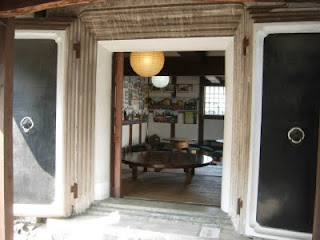 In modern-day Kyoto new building sites are blessed in the name of otafuku prior to construction.
In modern-day Kyoto new building sites are blessed in the name of otafuku prior to construction.Wednesday, October 28, 2009
A Japanese Miscellany: Otafuku (お多福)
The balloon-faced mask painted a spectral white with ruby lips and depressed nose is called otafuku (お多福). As her name indicates, she is a symbol of good fortune, literally meaning "lots of luck". She dates from the Muromachi era (1336-1573), when chubbiness in women was indicative of wealth, as indeed it was until well into the 20th century. Traditionally otafuku masks were worn by dancers at festivals, and nowadays the masks are occasionally seen in commercial establishments.  In modern-day Kyoto new building sites are blessed in the name of otafuku prior to construction.
In modern-day Kyoto new building sites are blessed in the name of otafuku prior to construction.
 In modern-day Kyoto new building sites are blessed in the name of otafuku prior to construction.
In modern-day Kyoto new building sites are blessed in the name of otafuku prior to construction.Saturday, October 24, 2009
The SL Aso Boy




Twelve years ago my wife and I traveled to the main southern island of Kyushu. I was something of a Japan Rail fanatic at the time, and I wanted to ride the length of Japan on the country's rail network, which is operated by the regional Japan Rail companies. Thus it was that we flew from Tokyo to Fukuoka in November of 1997 and rode the JR Kyushu Tsubame Express as well as the steam locomotive SL Aso Boy. JR is one of the better ways to see the country, and for tourists, the JR Pass is the cheapest mode of inter-prefectural travel.
Saturday, October 17, 2009
Thanks, Japan Rail East
-



Don and I were exhausted after our longer and harder than expected cycle trip to Kitakatta (see previous posts). So, after ramen and sightseeing, we made our way to the station, purchased tickets, and waited for the down train to arrive- rather than cycle back. Meanwhile, Don packed his bike into a carrier, while I simply removed my front wheel and begged the station master to let me through the gate- which he promptly did. The regional Japan Rail companies, offshoots of the former nationalized Japan Rail, do not charge passengers extra fare for such items as skis, snowboards, or bikes, provided the items are properly stowed. But as my experience shows, JR staff, whom I have invariably found to be kind and helpful, will sometimes waive the rules. Don't, however, attempt to take even a collapsible bike with you on a crowded commuter train.
Friday, October 02, 2009
Miscellaneous Kitakata Sights




Kitakata, Fukushima, has preserved more of its architectural heritage than most Japanese cities. Like Otaru, Hokkaido, the city relies heavily on tourist traffic, and tourists have plenty of reason to visit this picturesque little city.
Kitakata Sights



In addition to ramen, Kitakata is famous for its kura, or traditional barn-like storehouses. Kura were formerly used by wealthier Japanese to protect their valuables from the ravages of fire and other disasters. They were also built by traders to store merchandise. Today many of these structures have been converted into galleries, cafes, and museums. I took photos of these and other quaint buildings while cycling around the city centre.
Ramen!


Kitakata boasts over 200 ramen shops, but in Don's mind there might as well be only one: Katsuan. So it was to Katsuan that we went. Just up the street a hungry crowd queued for its 15 minutes of ramen fame- at the busier establishments diners are encouraged to slurp and skeedaddle. But when we entered Katsuan there was only one other diner (though several yet-to-be-cleared tables attested that business was brisk). I ordered miso (fermented soy-bean paste) ramen, while Don ordered shoyu ramen with extra pork. Incidentally, one of my favorite Japanese movies is the late Itami Juzo's "Tampopo", an entertaining film about the struggles and ultimate success of a ramen shop owner.
Thursday, October 01, 2009
Kitakata- Finally

After 65 km, most of it uphill, the road signs announced we were entering the precincts of our destination, Kitakata. As we rolled into town, I took a picture of Jizo, patron of travelers. Kitakata is a lovely town of about 55,000 and, with over 200 Chinese noodle shops, it is Japan's per capita ramen capital.
Respite
Subscribe to:
Posts (Atom)















